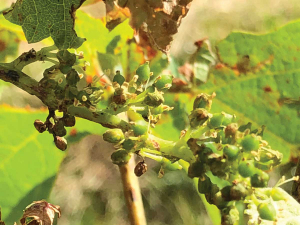A new research project will help inform vineyard recovery strategies following hail, after three separate events hit New Zealand vineyards last spring.
Approximately 600 hectares of vines in Hawke’s Bay were damaged by an October hailstorm, with further damage in Central Otago and North Canterbury in November. The Bragato Research Institute (BRI) has launched a two-year project to learn from the experiences of the vineyard managers affected, and fill the knowledge gap around hail events, says project leader Len Ibbotson.
He says there is limited information around recovery strategies following frost as well, but vineyard managers looking after a vineyard in a frost-prone area are likely to deal with the problem each season, and therefore have information and systems in place to manage and prevent damage. “For hail, there are no prevention strategies employed in New Zealand vineyards. They tend to be quite random events. There is much more chance you are going to encounter a hail event and have never dealt with it before,” he says. “That provides motivation for me to work with growers affected, learn from them, and document their experiences.”
Len says it is likely that each year there will be a hail event in one of New Zealand’s wine regions, although not in the same place. “The random nature of hail means it is important to broaden the information base available to growers, so they can react quickly and make decisions,” he says. “It is really hard on growers and their teams when you see all the hard work of a season undone by a weather event.”
The research project was started after a meeting in Hawke’s Bay on 15 October, when BRI and the New Zealand Winegrowers sustainability team members met with hail-affected growers and the local Rural Support Trust. “This research has come from that workshop, meeting with growers, and the fantastic work the Rural Support Trust does for growers and farmers in difficult times,” says Len. The research project will continue through to August 2021, and a group of eight growers affected by hail - four in Canterbury and four in Hawke’s Bay - will take part by recording field notes during the season, participating in interviews, and offering aggregate yield and relevant financial data for this growing season. Len says the information will enable their management decisions to be evaluated and linked to harvest outcomes.
There will also be a series of field trials in some vineyards to measure and evaluate the impact of hail damage, along with various post-hail treatment options. Vines will be monitored for two seasons to capture any potential carry-through of hail effects into the second season and evaluate interventions that growers may consider after hail damage.
The BRI has produced a draft scorecard for growers to help assess their vines after hail damage. When completed, it will offer growers a tool for evaluating and recording damage following a hail event, and may also help evaluate frost damage, says Len. The draft is available now, with feedback coming in from winegrowers who have trialled the resource. “I would like to have a final draft of that this winter, so it is ready and able to be used in the field for the next season.”












